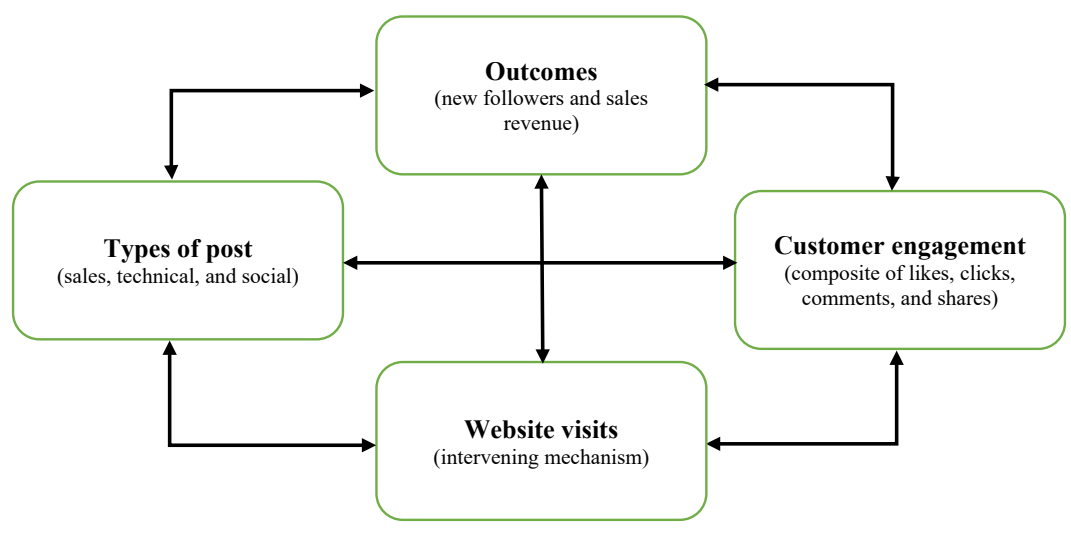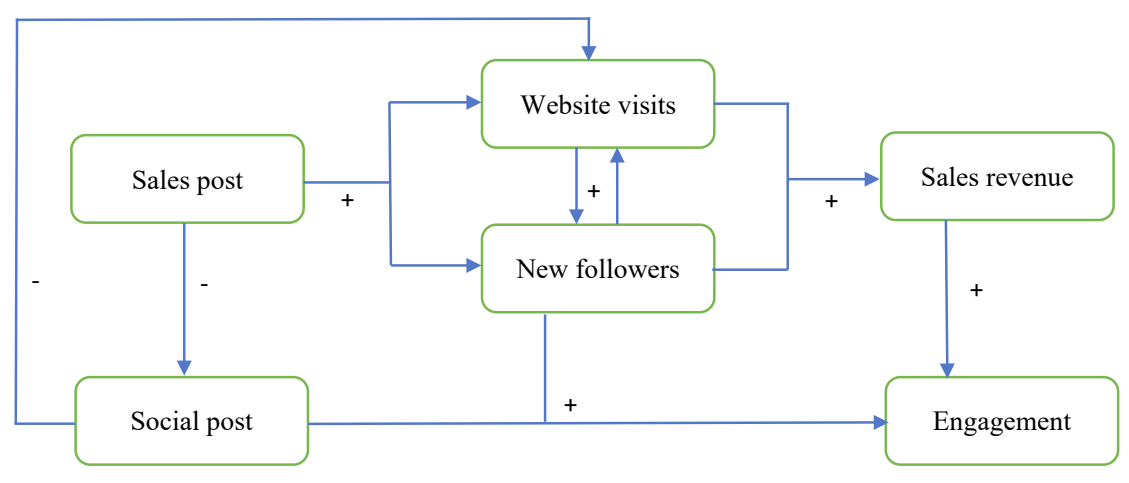Social media engagement is crucial for any business that wants to reach and connect with its customers. However, for B2B companies, social media engagement is not just about creating brand awareness or generating leads. It is also about building long-term relationships, establishing trust, and delivering value to your clients.
In this article, we will explore how social media engagement can impact B2B marketing and how you can use LinkedIn, the most popular professional network, to enhance customer interactions and drive business growth.
Case Study: The Recent research published in “The Journal of Business Research,” offers great insights into the impact of social media marketing on business performance, particularly in B2B marketing. The study focuses on the significance of new followers on social media platforms in generating sales revenue and engagement for firms. The researchers conducted a workshop with U.S. practitioners to understand how they classify posts in social media marketing. They found that existing content classification approaches do not align with the practitioners’ actual methods.
The research employed a VARX model to analyze the relationship between social media metrics and business performance. Using impulse response functions (IRFs), the study identified that increasing new followers positively affects sales revenue and engagement levels. The researchers highlighted the importance of growing the number of followers as a key driver of successful B2B social media marketing.
The research findings emphasized new followers’ role in enhancing a firm’s social media presence and driving sales. The acquisition of new followers emerges as a pivotal factor in enhancing social media engagement, resulting in a substantial 1% increase in sales revenue and a noteworthy 0.512% boost in engagement levels.
Website visits play a crucial role, significantly influencing the influx of new followers. Intriguingly, this relationship exhibits a feedback loop: a 1% rise in website visits contributes to a 0.140% increase in new followers, while a parallel 1% growth in followers results in a 0.274% surge in website visits.
Sales-related posts demonstrate a direct impact on both new followers and website visits. A 1% increase in sales posts corresponds to a 0.212% rise in new followers (from week 0 to week 2) and a 0.311% increase in website visits (from week 1 to week 3). Contrastingly, technical posts remain un-associated with other endogenous variables in the model. Social posts, however, exhibit a negative correlation with website visits, where a 1% increase leads to a 0.056% decrease (from week 2 to week 3). Notably, both social posts and sales revenue contribute positively to the overall level of engagement. A 1% upswing in social posts yields a 0.294% increase in engagement (from week 0 to week 2).
The findings underscore the impactful relationship between follower count and business outcomes. A mere 1% increase in followers manifests as a 0.591% surge in sales revenue and a 0.512% rise in engagement, showcasing the dual benefits of leveraging social media. Moreover, the intricate interplay between website visits and new followers unfolds a dynamic narrative.
The reciprocal effect suggests increased website visits lead to more followers, perpetuating a cycle that propels further website visits. Notably, a 1% impulse in new followers is nearly double the effect size compared to a 1% impulse in website visits (0.274% versus 0.140%).
These insights emphasize the strategic significance of social media, highlight the importance of a firm’s value proposition in converting followers into customers, and the role of increased post visibility in boosting engagement and substantiating its broader impact on firm-level metrics, particularly in driving sales revenue.
The research provides insights for firms looking to leverage social media platforms for marketing purposes and emphasizes the need to focus on growing the follower base to enhance sales revenue and engagement levels. By utilizing a VARX model and considering various social media metrics, the study offers valuable implications for firms aiming to improve their social media marketing strategies in the B2B context.
How a B2B Company Transformed Its Marketing Strategy Through LinkedIn Engagement
Let us start with a real-life example of how social media engagement can benefit a B2B company. We will look at the case of a B2B consultancy company in Latin America that provides services to the energy sector. The company faced several challenges in its marketing efforts, such as:
- Low brand recognition and visibility in the market
- High competition from other local and international firms
- Difficulty in reaching and engaging with decision-makers and influencers
- Lack of differentiation and value proposition

To overcome these challenges, the company decided to revamp its marketing strategy and focus on LinkedIn as its main channel for customer engagement. The company followed a three-step approach:
- Created a compelling company page on LinkedIn, highlighting its mission, vision, values, and expertise. It also showcased its portfolio of projects, testimonials, and awards.
- Developed a content strategy to educate, inform, and inspire its target audience. The company posted regularly on LinkedIn, sharing insights on industry trends, new technologies, best practices, and case studies. It also used different posts, such as text, images, videos, and polls, to attract attention and encourage feedback.
- Leveraged the power of storytelling to create emotional connections with its potential and existing clients. The company shared stories of how it helped its clients solve their challenges, achieve their goals, and improve their performance. It also highlighted the human side of its business, featuring its team members, culture, and values.
- The results of this strategy were impressive. The company saw a significant increase in its LinkedIn metrics. More importantly, the company also saw a positive impact on its business performance, such as:
- Increased brand awareness and reputation in the market
- Enhanced customer loyalty and satisfaction
- Higher conversion rates and sales revenue
- Improved customer retention and referrals
This example shows how social media engagement can transform a B2B company’s marketing strategy and help it achieve its business objectives.
What is Social Media Engagement in the B2B Context?
Social media engagement is the degree of interaction and involvement a user has with a brand or a company on social media platforms. It is measured by various indicators, such as likes, comments, shares, views, clicks, and follows.

However, social media engagement is not just about numbers. It is also about the quality and relevance of the content and the relationship a user has with a brand or a company. In B2B, social media engagement is more than just a marketing tactic. It is a strategic tool that can help B2B companies:
- Establish their credibility and authority in their industry
- Showcase their expertise and value proposition
- Educate and inform their target audience
- Generate and nurture leads
- Build and maintain trust and rapport with their clients
- Increase customer loyalty and advocacy
- Drive business growth and profitability
Therefore, social media engagement is a key factor for B2B marketing success and should be integrated into the overall marketing strategy of a B2B company.
How to Use LinkedIn for Customer Engagement and Brand Building
LinkedIn is the most widely used and trusted social media platform for professionals and businesses. LinkedIn offers various functionalities and features that can help B2B companies enhance their customer engagement and brand building, such as:
- Company Page: A company page is the online profile of a B2B company on LinkedIn. The company can showcase its brand identity, products/services, achievements, and updates. A company page can also help the company attract and engage with its target audience, generate leads, and drive traffic to its website.
- Content Marketing: Content marketing is creating and distributing valuable, relevant, and consistent content that aims to attract and retain a clearly defined audience and ultimately drive profitable customer action. Content marketing can help B2B companies educate and inform their potential and existing clients, establish their thought leadership, and differentiate themselves from their competitors. LinkedIn offers different types of content formats, such as text, images, videos, articles, and stories, that can be used to create engaging and informative content for the audience.
- LinkedIn Live: LinkedIn Live is a feature that allows B2B companies to broadcast live video content to their followers and the broader LinkedIn community. LinkedIn Live can help B2B companies showcase their expertise, share their insights, and interact with their audience in real time. LinkedIn Live can also help B2B companies increase their reach, visibility, and engagement on the platform.
- LinkedIn Events: LinkedIn Events is a feature that allows B2B companies to create and host online or offline events for their followers and the wider LinkedIn network. LinkedIn Events can help B2B companies promote events, invite and register attendees, and manage and track their event performance. LinkedIn Events can also help B2B companies create a sense of community, foster networking, and generate leads.
- LinkedIn Groups: LinkedIn Groups are online communities where B2B companies can join or create groups based on their industry, interests, or topics. LinkedIn Groups can help B2B companies connect and communicate with their peers, prospects, and clients, share their knowledge and opinions, and learn from others. LinkedIn Groups can also help B2B companies increase their exposure, credibility, and influence on the platform.
Using these functionalities and features, B2B companies can leverage LinkedIn for customer engagement and brand building and achieve their marketing goals.
How to Drive Engagement Behaviors on LinkedIn
Engagement behaviors are users’ actions on LinkedIn to interact with a B2B company’s content or profile. Engagement behaviors can be classified into two types:
- Passive engagement behaviors: These are the actions that users take to consume a B2B company’s content or profile, such as impressions, views, clicks, and follows. Passive engagement behaviors indicate the reach and awareness of a B2B company on LinkedIn.
- Active engagement behaviors: These are the actions that users take to express their interest or feedback on a B2B company’s content or profile, such as likes, comments, shares, and messages. Active engagement behaviors indicate the involvement and satisfaction of a B2B company’s audience on LinkedIn.
Both passive and active engagement behaviors are important for B2B marketing, as they contribute to customer interactions and relationships. However, active engagement behaviors are more desirable, as they reflect higher engagement and loyalty. Therefore, B2B companies should aim to drive more active engagement behaviors on LinkedIn by following these tips:
- Create relevant, valuable, and engaging content for your target audience. Use different content formats, such as text, images, videos, articles, and stories, to cater to different preferences and needs. Use catchy headlines, clear and concise language, and compelling visuals to capture attention and interest.
- Use hashtags, keywords, and tags to optimize your content for search and discovery. Hashtags, keywords, and tags can help your content reach a wider and more relevant audience on LinkedIn. They can also help your content rank higher on LinkedIn’s algorithm and increase visibility and engagement.
- Encourage feedback and participation from your audience. Ask questions, solicit opinions, request suggestions, and invite feedback from your audience. Respond to comments, messages, and inquiries promptly and politely. Acknowledge and appreciate positive feedback and address negative feedback constructively. Create a dialogue and a rapport with your audience and show them you value their input and engagement.
- Use analytics and insights to measure and improve your engagement. LinkedIn provides various analytics and insights tools that can help you track and evaluate your engagement performance on the platform. You can use these tools to measure your reach, impressions, views, clicks, follows, likes, comments, shares, and messages. You can also use these tools to identify your audience demographics, preferences, and behaviors. To improve your engagement, you can use this data to optimize your content, timing, frequency, and tone.
- By driving more engagement behaviors on LinkedIn, B2B companies can enhance their customer interactions and relationships and achieve their marketing objectives.
How to Use Storytelling to Create Content that Resonates with Your Audience
Storytelling is the art and science of using narratives to communicate a message, convey an emotion, or inspire action. Storytelling is a powerful tool for B2B marketing, as it can help B2B companies:
- Connect with their audience on an emotional level
- Showcase their brand personality and values
- Highlight their unique selling proposition and differentiation
- Demonstrate their expertise and credibility
- Illustrate their customer success stories and testimonials
- Motivate their audience to take action
- Therefore, B2B companies should use storytelling to create content that resonates with their audience and drives engagement.
Conclusion
Social media engagement is a vital component of B2B marketing, as it can help B2B companies build and maintain strong customer relationships, enhance their brand reputation, and drive their business growth. LinkedIn is the most suitable and effective platform for B2B marketing, as it offers various functionalities and features that can help B2B companies create and distribute engaging and informative content, connect and communicate with their target audience, and generate and nurture leads. Using storytelling, B2B companies can create content that resonates with their audience and motivates them to act.
We hope this article has provided you with some useful insights and tips on how to leverage social media engagement in B2B marketing. If you want to learn more about improving your social media marketing strategy, please contact us or follow us on LinkedIn. We would love to hear from you and help you achieve your marketing goals. Thank you for reading and stay tuned for more articles from us. 😊
